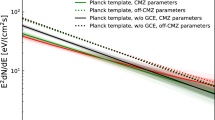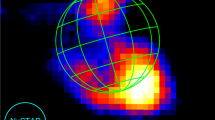Abstract
WE report here the results of the measurements of the abundances of Ca, Ti and Cr nuclei relative to Fe, in low energy cosmic rays in 25–100 MeV/a.m.u. interval, which were measured in a dielectric detector assembly exposed on the outside of Skylab III for 73 d. The collecting power (defined as the product of area and exposure time) of the lexan detector in this experiment was the largest so far used in free space—1.1 × 109 cm2 s and the period of exposure from November 22, 1973 to February 3, 1974 was exceptionally ‘quiet’ (free from solar activity). These factors enabled us to make a reliable study of the abundance of these low energy cosmic-ray nuclei. The results on the measurements of the low energy oxygen group of nuclei in the same detector have been reported earlier1. We found an interesting feature in the enhanced abundances of low energy Ca–Cr nuclei relative to Fe, which are different from the composition of high energy (> 1 GeV/a.m.u.) cosmic rays, but are similar to those of low energy cosmic-ray nuclei observed in interplanetary space2,3. In the present work, however, observations have been made down to an energy of 25 MeV/a.m.u., which is a factor of two lower than those in earlier studies.
This is a preview of subscription content, access via your institution
Access options
Subscribe to this journal
Receive 51 print issues and online access
$199.00 per year
only $3.90 per issue
Buy this article
- Purchase on Springer Link
- Instant access to full article PDF
Prices may be subject to local taxes which are calculated during checkout
Similar content being viewed by others
References
Biswas, S., et al. Astrophys. Space Sci., 35, 337–347 (1975).
O'Sullivan, D., Thompson, A. and Price, P. B., Nature, 243, 8–9 (1973).
Fleischer, R. L., Hart, H. R., Jr, and Ranshaw, A., G.E. Tech. Rep. Wo. 74-CR D-138 (Schenectady, New York 1974).
Price, P. B., and Fleischer, R. L. A., Rev. nucl. Sci., 21, 295–334 (1971).
Webber, W., Damle, S. V., and Kish, J., Astrophys. Space Sci., 15, 245–271 (1972).
Chan, J. H., and Price, P. B., Astrophys. J., 190, L39–41 (1974).
Mogro-Campero, A., Schafield, N., and Simpson, J. A., Proc. 13th Int. Cosmic Ray Conf., 1, 140–145 (1973).
Shea, M. A., and Smart, D. F., Report No. AFCRL-TR-75-0185 (Air Force Cambridge Research Laboratories, Massachusetts, USA, 1975).
White, R. S., Rev. Geophy. Space Phys., 11, 595–632 (1973).
Pagel, B. E. J., Space Sci. Rev., 15, 1–21 (1973).
Author information
Authors and Affiliations
Rights and permissions
About this article
Cite this article
BISWAS, S., NEVATIA, J., DURGAPRASAD, N. et al. Enhanced abundances of Ca, Ti and Cr in low energy cosmic rays in Skylab experiment. Nature 258, 409–412 (1975). https://doi.org/10.1038/258409a0
Received:
Accepted:
Issue Date:
DOI: https://doi.org/10.1038/258409a0
This article is cited by
-
Observations of enhanced sub-iron (Sc-Cr) to iron abundance ratios in the low energy galactic cosmic rays in Spacelab-3 and their implications
Journal of Astrophysics and Astronomy (1994)
-
Estimation of the sub-iron-iron flux ratio in cosmic rays over alice springs using a balloon flight experiment with a CR-39 detector
Astrophysics and Space Science (1993)
-
Sub-iron to iron nuclei in low-energy (50?200 MeV nucl?1) cosmic rays as observed in the Skylab experiment
Astrophysics and Space Science (1988)
-
Ionization states of cosmic rays:Anuradha (IONS) experiment in Spacelab-3
Pramana (1986)
-
Relative abundances of 10?Z?26 nuclei in medium energy cosmic rays
Astrophysics and Space Science (1980)
Comments
By submitting a comment you agree to abide by our Terms and Community Guidelines. If you find something abusive or that does not comply with our terms or guidelines please flag it as inappropriate.



